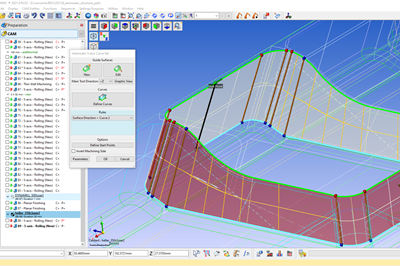Digital Twin Software Update Enhances Functionality
NCSIMUL 2021 from Hexagon Production Software further increases shop-floor productivity and reduces manufacturing costs with improvements to detecting excess material, setup editing and wear on cutting tool simulation.

All photo credit: Hexagon
An array of new and enhanced functionality is said to keep NCSIMUL, the latest digital twin software from Hexagon Production Software, at the forefront of Industry 4.0 Smart Factory technology by increasing CNC program quality with automatic and predictive analysis.
Virtually building the real-life machining environment to avoid errors, decrease setup times and switch CNC programs between machines, NCSIMUL’s 2021 release features a new comparison mode that detects excessive material during a fast and hidden simulation. It shows a solid comparison between the CAD/CAM models or previous cut stock and the NCSIMUL simulated model.
Technical Director Philippe Legoupi says this new item of functionality is the only way to detect unwanted rest stock on a large part. It identifeies a list of the excess material that’s left, and can also be displayed in a 3D window linked to the list. Among its benefits is the ability to find small, missing drill holes on large aerospace components and missing holes that need to be connected on mold bodies and hydraulic parts.
Integrated to NCDoc, Dimensioning is a new function which creates control instructions for operators during the CNC process. It defines a dimension check-list with user-defined tolerances, automatically defines the minimum measurement needed for each cut, generates a comprehensive view for the programmer and operator on the 3D simulation, and works with the NCDoc documentation template. This saves time and money says Hexagon, particularly when using the Wizard to create the correct number of measurements, even when using a probe tool on the machine.
A new set of options quickly evaluate tools that can benefit from air-cutting optimization, with the ‘out of material working time’ in the sequence list. This works with the NCDoc documentation template, and customizes stock nearness values for each sequence; the optimization is automatically stored for future strategies.
Enhancements to editing Setup further reduce simulation time by merging fixtures, parts and rough stock elements from one, or multiple, CAD files read in NCSIMUL. It creates simple, geometric rough stock—either cylinder or cubes—an automatic part envelope and all setup elements can move up or down.

Improvements to mill-turn tooling include management for ESPRIT CAM and TopSolid CAM interfaces. With a new ‘configuration interface file’ associated to each digital twin, it is now possible to define the mapping of tool-assembly positioning—station number, turret and orientation—between the CAM system and NCSIMUL. This means the interfaces can create NCSIMUL projects ready to run the simulation.
A simplified 2D display for turning parts also improves the analysis of dynamic rough stock, enabling a quick display of the tool and toolpath next to the cut model and reference part profiles.
The document center is now available online, and includes additional descriptions of the released versions, including more details under the ‘case studies’ and ‘focus on’ tabs.
Finally, for cutting-tool wear simulation as defined in the tool magazine, a button now runs the simulation for tools either ‘fresh out of the box,’ or ‘worn down.’ User-defined values apply for each cutting tool, and the system can check if a worn tool will generate alarms or collisions with unwanted rest stock material. This defines the sharpening rules, and decreases tool consumption.
Related Content
Three Good Reasons to Switch from Three- to Five-Axis Machining in Moldmaking
Five-axis machining technology is a great tool in the moldmaker toolbox.
Read MoreHow to Select a Mold Temperature Controller
White paper shares how cooling channel analysis, which collects maximum pressure drop, total flow rate and heat dissipation, eases the performance evaluation of mold temperature controllers.
Read MoreHow to Manage Wall Thickness Changes in Your Mold Design
To ensure even filling and cooling, consider wall section transitions, corners and fillets, ribs and bosses, lip and rim designs and CAE flow simulation software.
Read MoreWhat is Scientific Maintenance? Part 2
Part two of this three-part series explains specific data that toolrooms must collect, analyze and use to truly advance to a scientific maintenance culture where you can measure real data and drive decisions.
Read MoreRead Next
EDGECAM 2021 Software Ensures Faster Waveform Roughing Functionality
The updated CAD/CAM software from Hexagon Production Software boosts customer productivity with lower computer-processing time and faster toolpaths.
Read MoreFaster WORKNC Delivers on Performance
The Hexagon WORKNC 2021 software release offers faster toolpaths and a simpler user experience for improved productivity.
Read MoreHow to Use Continuing Education to Remain Competitive in Moldmaking
Continued training helps moldmakers make tooling decisions and properly use the latest cutting tool to efficiently machine high-quality molds.
Read More





















